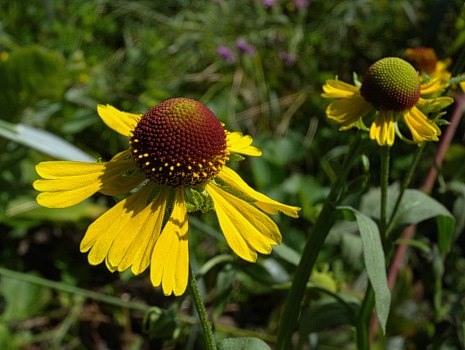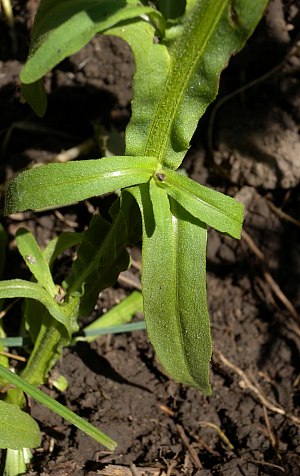Description: This herbaceous perennial wildflower is 1½–3' tall with each stem branching occasionally in the upper half. Because of vegetative offsets, multiple stems usually develop. The pale to medium green stems are strongly winged from the decurrent leaves; they are usually canescent, but some populations of plants can have either glabrous or hairy stems. The alternate leaves are up to 3" long and 1" across; they are pale to medium green, lanceolate to narrowly ovate, smooth along their margins, and canescent to glabrous. The base of each leaf clasps the stem, forming decurrent extensions of the leaf along the stem below.

The upper stems
terminate in individual flowerheads about 1" across. Each flowerhead
has a globoid center about ½" across that consists of many disk florets
that are purple to brown. Surrounding the center of the flowerhead,
there are 8-14 ray florets. The petaloid rays of these latter florets
are bright yellow, V-shaped (narrow at the base, broad at the tip), and
slightly drooping; the tip of each ray is defined by 3 rounded lobes.
At the bottom of each flowerhead, there is a single series of floral
bracts that are pale green and lanceolate in shape; they become
recurved when the flowerheads are in bloom. The blooming period occurs
from mid-summer to early fall and lasts about 2 months. The rays fall
to the ground, while the disk florets in the globoid center develop
into small achenes. Each achene is about 1.0 in length or a little
longer and bullet-shaped; there is a crown of awned scales at its apex.
The root system is fibrous, forming vegetative offsets.

Cultivation:
The preference is full or partial sun, wet to moist conditions, and a
slightly acid soil. This wildflower will wilt if it is allowed to dry
out. Temporary flooding is tolerated.
Range & Habitat: Purple-Headed
Sneezeweed is common in southern Illinois and uncommon in
central Illinois, where it is native; in the northern section of the
state, where this wildflower is
rare, local populations probably derive from escaped cultivated plants
(see Distribution
Map). Habitats include thinly wooded swamps, soggy
riverbottom meadows, wet prairies, moist swales in upland prairies,
moist depressions in rocky glades, borders of sinkhole ponds, ditches,
pastures, and abandoned fields. This wildflower is found in both high
quality and disturbed habitats.
Faunal Associations:
The flowerheads offer nectar and pollen as floral rewards to a wide
range of insect visitors, including long-tongued bees, short-tongued
bees, wasps, flies, butterflies, and skippers. Various insects feed on
the leaves, pith of the stems, and other parts of Helenium
spp. (Sneezeweeds). These species include the caterpillars of
the butterfly Nathalis iole (Dainty Sulfur), the
caterpillars of Papaipema impecuniosa (Aster Borer
Moth) and Papaipema rigida (Rigid Sunflower Borer
Moth), and Smicronyx discoideus (Sneezeweed
Weevil). Most of these insects also feed on other herbaceous species in
the Aster family. The Greater Prairie Chicken eats the seeds and dried
flowerheads of Helenium spp. to a limited extent.
Because the foliage is bitter-tasting and toxic, it is avoided by
cattle and other mammalian herbivores.
Photographic Location:
The wildflower garden of the webmaster in Urbana, Illinois.
Comments:
If you can find a sufficiently damp location for it, Purple-Headed
Sneezeweed is worth cultivating because of its attractive foliage and
flowerheads. Generally, Sneezeweeds (Helenium spp.)
can be distinguished from other species in the Aster family by the
globoid centers of their flowerheads, their V-shaped and 3-lobed
petaloid rays, and their strongly winged stems from the decurrent
leaves. Purple-Headed Sneezeweed is easily distinguished from Helenium
autumnale (Common Sneezeweed) by the purple to brown globoid
centers of its flowerheads; the globoid centers of the latter species
are yellow. Another species in Illinois, Helenium amarum
(Bitterweed), has very narrow leaves and it prefers drier habitats.
Another scientific name of Purple-Headed Sneezeweed is Helenium
nudiflorum.